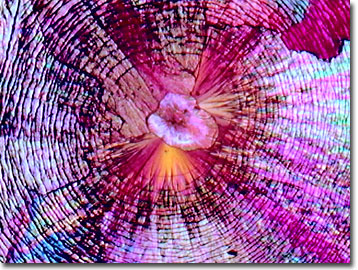Polarized Light Digital Image Gallery
Nicotinamide Adenine Dinucleotide (NAD)
Nicotinamide adenine dinucleotide (NAD) and the phosphate derivative, NADP, are two coenzymes that are regularly utilized in the body for electron-transfer biochemical reactions as carriers of hydrogen ions. NADH (the reduced form of NAD) is the active coenzyme form of vitamin B-3 and is necessary for the production of cellular energy and integral in the development of essential neurotransmitters.

View a second image of nicotinamide adenine dinucleotide.
View a third image of nicotinamide adenine dinucleotide.
When the nucleotide adenosine (A) is coupled to a nicotinamide analog nucleotide, NAD and NADP are produced. Nicotinamide adenine dinucleotide phosphate (NADP) is simply NAD with a third phosphate group attached, and is very important in the energy transformation process of photosynthesis. While the oxidized form is represented as NAD+, the reduced form is recognized as NADH. Several investigators have speculated that NAD and vitamin B-12 might be evolutionary remnants of the original RNA-based metabolism that predates the current genetic code. Nicotinamide adenine dinucleotide is also available as pharmaceutical and reagent-grade synthesized white crystals.
Deficiencies in vitamin B-3 occur with alcoholics and result in NADH deficiencies. Therapies for chronic fatigue syndrome, Alzheimer's disease, congestive heart failure, and Parkinson's disease are based on administering doses of nicotinamide adenine dinucleotide. Natural sources for NAD dietary intake are the muscle tissue of fish, poultry, and cattle, as well as yeasty foods such as breads and ale. NADH acts as an antioxidant and enzyme facilitator. Lower levels of the coenzyme are associated with aging and may explain a general lack of energy in deficient individuals. NADH as a supplement may aid in the treatment of migraine headaches, diabetes, depression, and some respiratory problems. In the brain, medical research indicates that nicotinamide adenine dinucleotide improves alertness and concentration, and helps balance moods and emotions by allowing the proper functioning of the enzyme monoamine oxidase.
Contributing Authors
Omar Alvarado, Thomas J. Fellers and Michael W. Davidson - National High Magnetic Field Laboratory, 1800 East Paul Dirac Dr., The Florida State University, Tallahassee, Florida, 32310.
BACK TO THE POLARIZED LIGHT IMAGE GALLERY
BACK TO THE DIGITAL IMAGE GALLERIES
Questions or comments? Send us an email.
© 1995-2025 by Michael W. Davidson and The Florida State University. All Rights Reserved. No images, graphics, software, scripts, or applets may be reproduced or used in any manner without permission from the copyright holders. Use of this website means you agree to all of the Legal Terms and Conditions set forth by the owners.
This website is maintained by our
Graphics & Web Programming Team
in collaboration with Optical Microscopy at the
National High Magnetic Field Laboratory.
Last Modification Friday, Nov 13, 2015 at 01:19 PM
Access Count Since September 17, 2002: 8510
Visit the website of our partner in introductory microscopy education:
|
|
